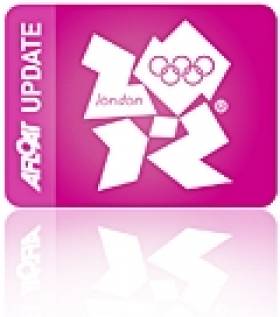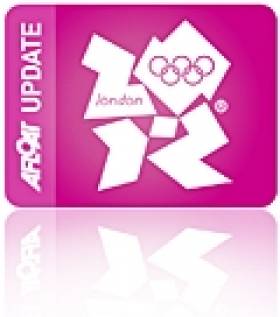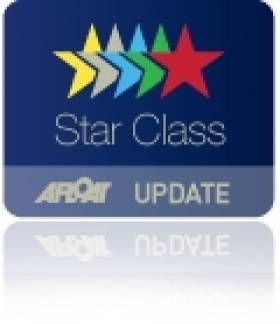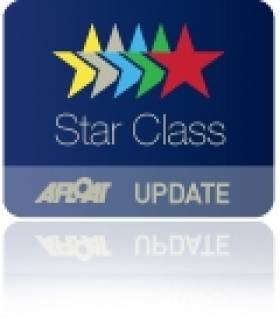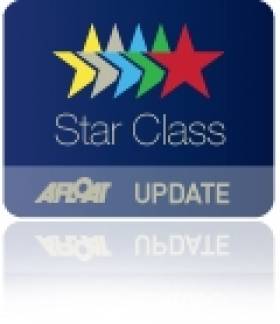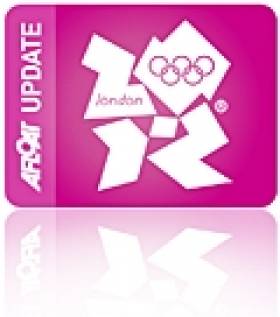Displaying items by tag: Star
Black Flag Setback for O'Leary/Burrows in Perth
#PERTH 2011 –There has been a setback to the Peter O'Leary and David Burrows Star keelboat campaign today following their disqualification from the sixth race when the Irish crew were lying second.

Star keelboats line up for a world championship start in Perth. The Irish Star was judged to be over the line in race six. Photo: Richard Langdon
It means the pair are now in a real fight to secure Olympic qualification. The top 11 nations will qualify for next year's Olympic regatta and the Irish pair are currently 11th nation. Swiss, Italian, Greek and Croatian rivals are all vying for the final slot and can still overhaul the Irish boat.
The pair were pulled from the race by officials who judged them to have been premature starters in race six. The subsequent disqualifcation drops them to 14th overall as they must now count the 33rd placing scored in race four.
After five races sailed the Dublin-Cork combination were only one point off third overall earlier today.
A post on the team facebook page today simply says:
Simpson said: "We had an okay run, but Iain hurt his back and was in tears. It looks like it's his lower back, but we don't know yet. No way could we have raced the second race."
"It's frustrating; sadly this is the second event in a row Iain has injured himself. He injured his ankle last time," he said. "I guess we won't be sailing, but we never rule anything out."
Shortly after the race, Percy said on his Twitter account: "My back fully went today half way through the first race. Unfortunately the end of the championships and the beginning of a few weeks of physio."
On the penalty that ended their race, Simpson said: "Sadly we picked up a yellow flag and we don't know why – we're still confused."
Race 5 was won by Mateusz Kusznierewicz and Dominik Zycki (POL), who led for the entire course.
Closely behind in second place were Robert Scheidt and Bruno Prada (BRA), well clear of the third placed German team, Johannes Polgar and Koy Markus.
In the sixth race, Scheidt and Prada had to settle for another second place after crossing the finish just two seconds behind Swedish pair Fredrik Loof and Max Salminen.
Finishing in third and with only one second separating them from the Brazilians were Kusznierewicz and Zycki.
After six races, Scheidt and Prada move into first position overall. Mendelblatt and Fatih (USA) and Kusznierewicz and Zycki (POL) trail the Brazilians by only one point.
O'Leary and Burrows Lie a Single Point off Third
#PERTH2011 – Keelboat pair Peter O'Leary and David Burrows are in a three way tie vying for third place overall after five races sailed at the Star world Championships in Perth today. The sole Irish contenders in the 42-boat fleet scored 11th in race five to put them on equal points with Brazil's Robert Sheidt and Poland's Matseix Kusznierewicz, former Olympic Gold medallists from the Laser and Finn classes respectively.
O'Leary, Schedit and Kusznierewicz all share 24 points, just one point shy of America's Mark Medendlatt and Brian Faith in the Bronze medal position. Although the Irish crew are shown sixth on the leaderboad after a single discard has been applied it could not be tighter as the event moves past the half way stage today. Race six results as we have them.
Third Place in Race Four Keeps O'Leary/Burrows in Top Ten
#PERTH2011–Peter O'Leary and David Burrows are back in the top ten of the ISAF Star World Championships in Perth today after briefly dropping to 13th from fifth overall, the result of a poor third race where they scored 33rd in their 42-boat fleet. They scored an excellent third place though in the second race of the day to put the sole Irish pair ninth overall on 46 points, the same tally as Portugal's Afonso Domingos and Frederico Melo in eighth.
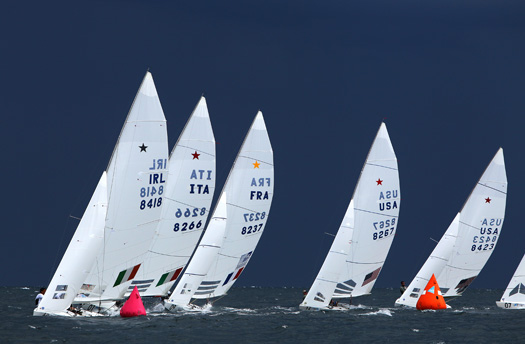
Leading the world - the Irish Star rounds the top mark first. Photo: Richard Langdon
Writing on their facebook page the Irish crew said: '
Another outstanding performance from the British Olympic Champions Iain Percy and Andrew Simpson consolidated their first place position in the overall standings after race four in the Star fleet.
Percy and Simpson have a total of 16 points while Mark Mendelblatt and Brian Fatih (USA) are on 28 points, with Germany's Robert Stanjek and Frithjof Kleen just behind them on 30.
"We had a good day today. We weren't going very well but we hung in and fought hard," Percy said. "My body is a bit bruised and battered for it but it's okay".
In race three, Norwegian team Eivind Melleby and Petter Morland Pedersen took first followed closely by Aimilios Papathanasiou and Antonios Tsotras of Greece.
The fight for third was close with Aimilios Papathanasiou and Antonios Tsotras of Greece just making it, putting Germany's Johannes Babendererde and Timo Jacobs in fourth place.
The outcome of race four saw the Swedish pair Fredrik Loof and Max Salminen take first place followed by Brazil's Robert Scheidt and Bruno Prada.
Third went to O'Leary and Burrows while British pair Percy and Simpson were fourth.
With six more races until the medal race the British are aware of the obstacles to come.
"There is still a long way to go, we're not super quick, so not confident we will get too far but we will keep battling to the end," he said.
Star racing is scheduled to continue on Tuesday on the Leighton course from 1300 Perth time.
O'Leary and Burrows Straight into Third Place
#PERTH2011 – Ireland's Peter O'Leary and David Burrows have sailed straight to the top of the Star keelboat leaderboard after the first day's racing of the ISAF world Championships today. The Cork-Dublin pairing are third overall having counted an 8 and 2 in the 42 boat fleet and just three points off leaders, the current Olympic Gold Medallists Iain Percy and Andrew Simpson from Great Britain.
The Irish Stsr boat is out of the water this evening having damage repaired after a second race collision, O'Leary and Burrows are working on the basis that all should be good by tomorrow for the important third race of the series.
Latest results here
O'Leary and Burrows Ready for First Gun in Perth
#PERTH2012 – Hotly tipped Irish keelboat duo Peter O'Leary and David Burrows race tomorrow for Olympic qualification and world championship honours in the first race of the Star keelboat worlds, the second week of the ISAF World Championships in Perth.
Belfast Lough 49er dinghy triallists Ryan Seaton and Matt McGovern and Royal North Laser sailor, James Espey both start racing on Monday.
Italian Victory, Ireland Fourth at Star European Championships
Another first place in the penultimate race for Italians Diego Negri and Enrico Voltolini sealed their series-long domination and overall victory at the Star European Championship (2nd-10th September) at Dun Laoghaire yesterday. Irish Olympic campaigners Peter O'Leary and Dvid Burrows finished an impressive fourth overall in the 27-boat fleet.
Photos on the Afloat Gallery by Gareth Craig HERE.
Light and shifty conditions followed by a sea breeze completed the regatta that delivered a full range of conditions for the 27-boat fleet from 18 nations.
Negri and Voltolini kept their form for a fourth race win and typically enjoyed a comfortable lead at the finish of race seven. For the crews chasing the runner-up podium positions, the breeze proved as challenging as it has been all week, this time dying to a near calm on the final run before filling gently on the left hand-side side of the course catching the unwary, notably Guillaume Florent and Pascal Rambeau who had been vying with the Italian leaders for first place.
A wait followed for the eighth and final race of the week but only after a long wait for the sea breeze to build and settle. This took the fleet away from the now familiar area off Dun Laoghaire's West Pier and southwards towards this historic Dalkey Island side of Dublin Bay. After starting in ideal conditions of 18 knots, halfway through the race the breeze died completely to be followed by a 90-degree wind-shift that saw 2008 World Champion Mateusz Kusznierewicz and Dominik Zycki emerge with a substantial lead on the water and, having led from the outset were confirmed as second overall runners-up. Negri and Voltolini had already retired as their position was no better than their already discarded eighth in race six and were busy packing their boat as the final ended.
Irish hopes of a podium result on home waters were denied to London 2012 Olympic contenders Peter O'Leary and David Burrows who placed fourth in the last race but a ninth earlier in the day left them fourth overall as Canada's Richard Clarke and Tyler Bjorn took third place.
Star European Championship 2011 at Royal St. George YC, Dun Laoghaire, Ireland
(Final overall after eight races):
1st ITA Diego Negri & Enrico Voltolini
2nd POL Mateusz Kusznierewicz & Dominik Zycki
3rd CAN Richard Clarke & Tyler Bjorn
4th IRL Peter O'Leary & David Burrow
5th NOR Eivind Melleby & Petter Morland Pedersen
6th POR Afonso Domingos & Frederico Melo
O'Leary and Burrows Slip to Fifth at Star Euros
Lighter winds saw Peter O'Leary and David Burrows drop to fifth place overall and Italians Diego Negri and Enrico Voltolini continue at the top of the leaderboard after three more races at the Star European Championships in Dun Laoghaire.
The weather gods finally allowed a full day of racing at the Championship at Dun Laoghaire as a moderate westerly breeze allowed three races. It is hoped to have two races tomorrow ahead of the forecast of yet more heavy winds that have dominated the championship so far.
With their form unchanged since Sunday, Italians Negri and Voltolini extended their overall lead in the 26-boat fleet, counting one win plus a third place while discarding their eighth place in race six.
Polish 2008 World champion and past Finn Olympic Gold medallist Mateusz Kusznierewicz with Dominik Zycki also showed good pace, with a fifth place and a win yesterday while discarding a ninth in the hunt for the overall lead. Canada's Richard Clarke with Tyler Bjorn also moved up a place to third overnight as the final two races are slated for Friday – weather permitting.
Star European Championship 2011 at Royal St. George YC, Dun Laoghaire, Ireland
(Provisional overall standings after six races):
1st ITA Diego Negri & Enrico Voltolini
2nd POL Mateusz Kusznierewicz Dominik Zycki
3rd CAN Richard Clarke & Tyler Bjorn
4th FRA Guillaume Florent & Pascal Rambeau
5th IRL Peter O'Leary & David Burrows
6th POR Afonso Domingos & Frederico Melo
Three Races Planned to Get Star Euros Back on Track
If winds ease tomorrow - and it is doubtful - three races of the Star European championships will be sailed to get the Dublin Bay regatta back on schedule.
High winds once again dictated the racing schedule at the Star European Championship at Dun Laoghaire on the third day of the series that has had two races out of the original eight-race programme completed.
The overnight offshore gale eased slightly during the morning and a two-hour postponement by principal race officer David Lovegrove offered some hope of racing for the 27 crews waiting at the Royal St. George YC.
However, gale force gusts continued and the programme was abandoned for the day leaving the sailors free to take the 20-minute train ride into the historic Dublin city-centre offering the famous Book of Kells at Trinity College, the Jameson Irish Whiskey centre and other attractions.
Star European Championship 2011 at Royal St. George YC, Dun Laoghaire, Ireland
(Overall standings after two races):
1st ITA Diego Negri & Enrico Voltolini
2nd FRA Guillaume Florent & Pascal Rambeau
3rd IRL Peter O'Leary & David Burrows
4th FRA Xavier Rohart Pierre & Alexis Ponsot
5th CAN Richard Clarke & Tyler Bjorn
6th POR Afonso Domingos & Frederico Melo
Photos HERE
40 Knot Winds Cancel Star Racing in Dun Laoghaire
Italians Lead, O'Leary/Burrows Third in Star Europeans
Ireland's Peter O'Leary and David Burrows lie third and only six points off the overall lead held by Italian's Diego Negri and Enrico Voltolini after the first two races of the Star European championships in Dun Laoghaire.
The staging of the Contintental Championship of the Olympic Class, in which Ireland has reasonable aspirations of taking an Olympic medal next year, is being run by the Royal St. George Yacht Club under Howth race officer David Lovegrove.
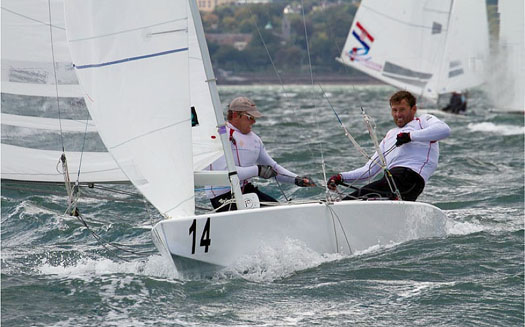
Star racing in big breeze on Dublin Bay yesterday. Photo: Gareth Craig. More pics on the Afloat Gallery here.
Ireland's other entry in the 27-boat fleet, Max Treacy and Anthnoy Shanks, of the host club lie 12th.
Second overall is France's Guillaume Florent and Pascal Rambeau. Britian's double Olympic gold medallists Iain Percy and Andrew Simpson, despite leading the first race for a time this afternoon, have posted an eighth and a seventh to lie eighth overall.
Racing on Dublin Bay continues tomorrow – under the threat of gales – until Friday.
Italians Negri and Voltolini delivered two consistent results of a race win and a second place in the 27-boat fleet from 17 nations.The Italians leaders were the 2006 European champions and overcame challenging post-frontal weather conditions that delivered 20-degree wind-shifts at times on an otherwise smooth race course off Seapoint on the south shore of Dublin Bay.
France's Guillaume Florent and Pascal Rambeau also had a consistent day with a second and third while the home fleet delivered a strong showing as Olympic veterans
Star European Championship 2011 at Royal St. George YC, Dun Laoghaire, Ireland
(Provisional overall standings after two races):
1st ITA Diego Negri & Enrico Voltolini
2nd FRA Guillaume Florent & Pascal Rambeau
3rd IRL Peter O'Leary & David Burrows
4th FRA Xavier Rohart Pierre & Alexis Ponsot
5th CAN Richard Clarke & Tyler Bjorn
6th POR Afonso Domingos & Frederico Melo































